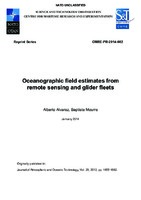| dc.contributor.author | Alvarez, Alberto | |
| dc.contributor.author | Mourre, Baptiste | |
| dc.date.accessioned | 2018-10-11T14:09:46Z | |
| dc.date.available | 2018-10-11T14:09:46Z | |
| dc.date.issued | 2014/01 | |
| dc.identifier | 47926 | |
| dc.identifier.govdoc | CMRE-PR-2014-002 | |
| dc.identifier.uri | http://hdl.handle.net/20.500.12489/678 | |
| dc.description.abstract | This work investigates the merging of temperature observations from a glider fleet and remote sensing, based on a field experiment conducted in an extended coastal region offshore La Spezia, Italy, in August 2010. Functional optimal interpolation and spline formalisms are used to integrate temperature profiles from a fleet of three gliders with remotely sensed sea surface temperature into a volumetric thermal field estimate. Independent measurements from a towed ScanFish vehicle are used for validation. Results indicate that the optimal interpolation approach performs better than the spline model at and above the thermocline depth as long as anisotropic covariances computed from the remote sensing data are used. Below the thermocline, the two merging techniques give similar performance. | |
| dc.format | 6 p. : ill. ; digital, PDF file | |
| dc.language | English | |
| dc.publisher | CMRE | |
| dc.source | In: Journal of Atmospheric and Oceanic Technology, vol. 29, issue 11 (November 2012), pp. 1657-1662. | |
| dc.subject | Remote sensing | |
| dc.subject | Underwater gliders | |
| dc.subject | Ligurian Sea | |
| dc.subject | Sea surface temperature (SST) | |
| dc.subject | Ocean thermocline | |
| dc.subject | Interpolation | |
| dc.subject | Spline theory | |
| dc.subject | Seawater thermal properties | |
| dc.subject | Sensor networks | |
| dc.subject | Multisensor data fusion | |
| dc.subject | REP'10 trial | |
| dc.title | Oceanographic field estimates from remote sensing and glider fleets | |
| dc.type | Reprint (PR) | |
| dc.type | Papers and Articles | |
